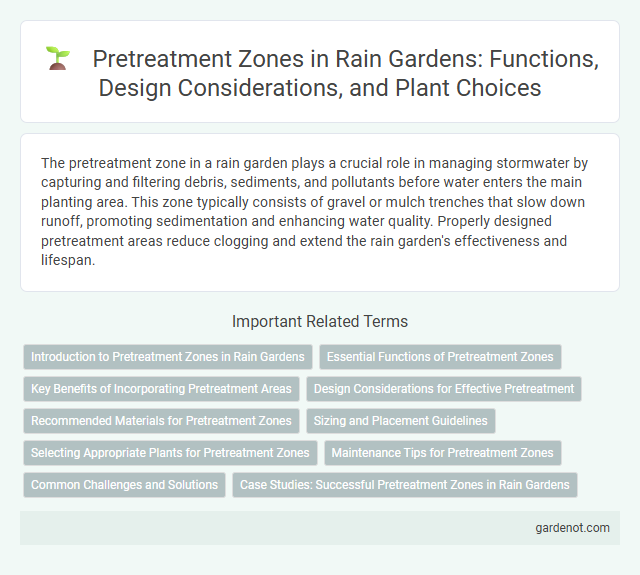The pretreatment zone in a rain garden plays a crucial role in managing stormwater by capturing and filtering debris, sediments, and pollutants before water enters the main planting area. This zone typically consists of gravel or mulch trenches that slow down runoff, promoting sedimentation and enhancing water quality. Properly designed pretreatment areas reduce clogging and extend the rain garden's effectiveness and lifespan.
Introduction to Pretreatment Zones in Rain Gardens
Pretreatment zones in rain gardens serve as the first line of defense by capturing sediments, debris, and pollutants from stormwater runoff before it enters the main infiltration area. These zones typically include features such as forebays, sedimentation basins, or filter strips designed to reduce clogging and enhance overall water quality. Effective pretreatment improves the longevity and performance of rain gardens by preventing soil compaction and maintaining infiltration rates.
Essential Functions of Pretreatment Zones
Pretreatment zones in rain gardens play a crucial role in filtering out sediment, debris, and pollutants before water enters the main infiltration area. They enhance water quality by promoting sedimentation and allowing organic matter to break down, reducing clogging and extending the lifespan of the rain garden. Effective pretreatment zones support optimal infiltration and improve overall stormwater management efficiency.
Key Benefits of Incorporating Pretreatment Areas
Incorporating pretreatment zones in rain gardens significantly enhances pollutant removal by capturing sediments, oils, and debris before water enters the main filtration area. These zones reduce maintenance needs by preventing clogging and prolonging the functional lifespan of the rain garden system. Pretreatment areas optimize water quality improvement and support sustainable stormwater management practices in urban environments.
Design Considerations for Effective Pretreatment
The pretreatment zone in a rain garden is crucial for capturing sediments, debris, and pollutants before water enters the main infiltration area. Design considerations include incorporating sediment traps, forebays, or filter strips to enhance pollutant removal and prevent clogging. Proper sizing based on runoff volume and vegetation selection ensures efficient flow distribution and prolongs the rain garden's functional lifespan.
Recommended Materials for Pretreatment Zones
Recommended materials for pretreatment zones in rain gardens include coarse gravel, shredded mulch, and sand to effectively filter sediments and pollutants. Incorporating bioretention media with high organic content enhances contaminant removal while maintaining adequate drainage. Selecting materials with optimal particle size distribution ensures durability and improved water quality before infiltration.
Sizing and Placement Guidelines
The pretreatment zone of a rain garden should be sized to handle at least the first 0.5 inches of runoff from the contributing drainage area, which typically represents the majority of pollutant load. Placement guidelines recommend locating the pretreatment zone at the inflow point to capture sediments and debris before they enter the main infiltration area, preventing clogging and maintaining garden performance. Proper sizing and placement ensure effective sediment removal and prolong infiltration capacity in rain garden systems.
Selecting Appropriate Plants for Pretreatment Zones
Selecting appropriate plants for pretreatment zones in rain gardens involves choosing species with high pollutant uptake and strong root systems to enhance infiltration and filtration efficiency. Native plants such as sedges, rushes, and certain grasses are ideal because they tolerate fluctuating moisture levels while providing habitat benefits and stabilizing soil. Incorporating diverse plant species ensures resilience against drought, overflow events, and helps prevent erosion within the pretreatment area.
Maintenance Tips for Pretreatment Zones
Maintain pretreatment zones in rain gardens by regularly removing accumulated sediment, debris, and invasive vegetation to ensure optimal filtration performance. Inspect pretreatment areas monthly, especially after heavy rainfall, to prevent clogging and promote water infiltration. Use mulch or filter fabric layers to protect soil structure and reduce erosion, enhancing long-term effectiveness.
Common Challenges and Solutions
Pretreatment zones in rain gardens often face challenges such as sediment buildup and clogging, which reduce infiltration efficiency and increase maintenance needs. Implementing level spreaders and sediment forebays helps capture debris and evenly distribute flow, enhancing water quality and system longevity. Regular inspection and removal of accumulated sediments prevent blockage and maintain optimal stormwater treatment performance.
Case Studies: Successful Pretreatment Zones in Rain Gardens
Case studies of successful pretreatment zones in rain gardens reveal the critical role of sediment forebays and vegetated filter strips in enhancing pollutant removal efficiency. Design elements such as graded gravel beds and native plant species significantly improve water infiltration and reduce sediment buildup, as demonstrated in urban projects across Seattle and Portland. These implementations highlight measurable improvements in stormwater quality by effectively capturing debris and sediments before water enters the main rain garden basin.
Pretreatment zone Infographic

 gardenot.com
gardenot.com